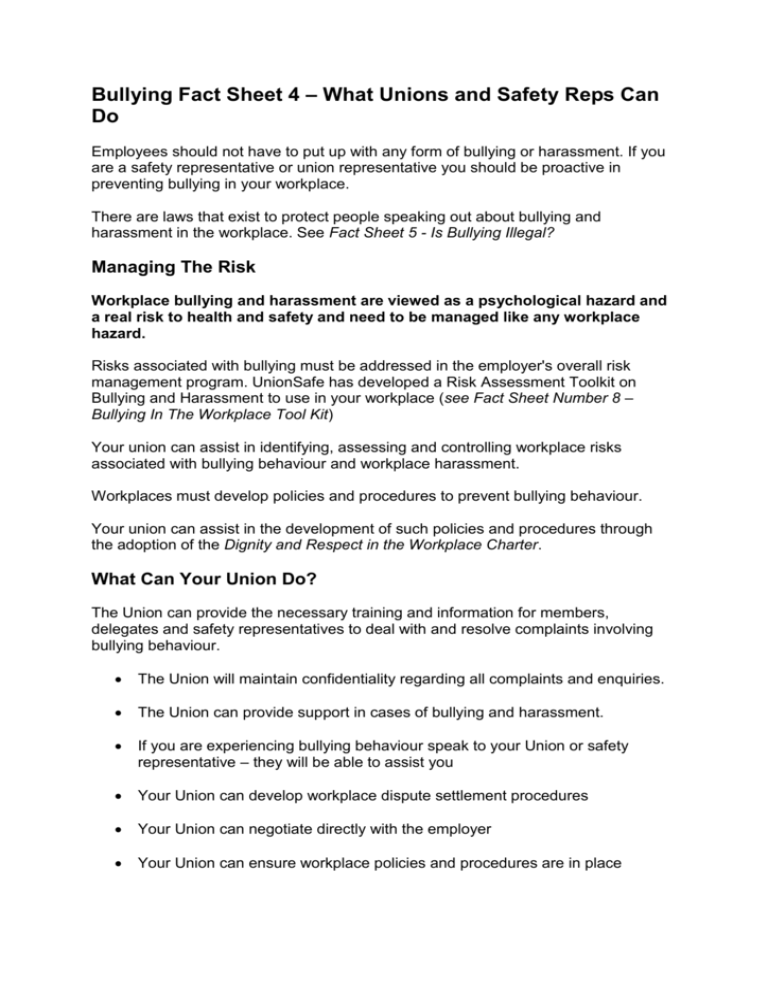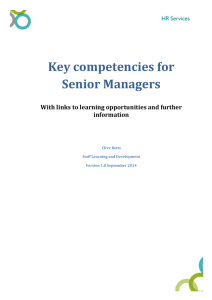Unions view bullying as a form of workplace violence and a real risk
advertisement

Bullying Fact Sheet 4 – What Unions and Safety Reps Can Do Employees should not have to put up with any form of bullying or harassment. If you are a safety representative or union representative you should be proactive in preventing bullying in your workplace. There are laws that exist to protect people speaking out about bullying and harassment in the workplace. See Fact Sheet 5 - Is Bullying Illegal? Managing The Risk Workplace bullying and harassment are viewed as a psychological hazard and a real risk to health and safety and need to be managed like any workplace hazard. Risks associated with bullying must be addressed in the employer's overall risk management program. UnionSafe has developed a Risk Assessment Toolkit on Bullying and Harassment to use in your workplace (see Fact Sheet Number 8 – Bullying In The Workplace Tool Kit) Your union can assist in identifying, assessing and controlling workplace risks associated with bullying behaviour and workplace harassment. Workplaces must develop policies and procedures to prevent bullying behaviour. Your union can assist in the development of such policies and procedures through the adoption of the Dignity and Respect in the Workplace Charter. What Can Your Union Do? The Union can provide the necessary training and information for members, delegates and safety representatives to deal with and resolve complaints involving bullying behaviour. The Union will maintain confidentiality regarding all complaints and enquiries. The Union can provide support in cases of bullying and harassment. If you are experiencing bullying behaviour speak to your Union or safety representative – they will be able to assist you Your Union can develop workplace dispute settlement procedures Your Union can negotiate directly with the employer Your Union can ensure workplace policies and procedures are in place Your Union can include relevant OHS Clauses in enterprise agreements. An example of a draft clause is as follows: Dignity and Respect in the Workplace Clause Text of clause to be inserted into enterprise agreement Your Union can represent you in the Workers Compensation Commission, conciliation and/or arbitration in industrial tribunals and pursue cases in the Industrial Commission or other relevant jurisdictions Your Union can assist you in the process of conducting a risk assessment Unions can prosecute employers for breaches of the OHS Act and Regulation Your Union can monitor the WorkCover claim history of your workplace to establish if patterns are developing Your Union can assist members in their workers compensation claims and rehabilitation Your Union can arrange for counselling for those affected by workplace bullying. How OHS Reps and Committees can help The most effective way to prevent bullying is for employers to send a clear message that workplace bullying is unacceptable. The following are some steps that you and your work colleagues can take to minimise and prevent bullying. The first step in prevention is to acknowledge that bullying can exist in any workplace. The Dignity and Respect in the Workplace Charter sets out the steps necessary to create a harmonious and bully-free workplace. Support and involvement from senior management is essential in effecting change to prevent bullying before it becomes a problem. Occupational Health and Safety Committees and OHS Representatives are ideally placed to deal with these issues. Under the new consultative arrangements you: Must be consulted about minimising risks in your workplace. Will be able to obtain high-level support, through workplace consultation processes, from senior management for implementing a comprehensive strategy to address bullying. Will be able to develop, through OH&S consultative processes and adoption of the Dignity and Respect in the Workplace Charter, a Workplace Code of Conduct that prohibits bullying. Your Union and OH&S Representatives Should Ensure That Your Organisation: Regularly distributes and promotes your Workplace Code Of Conduct at all levels of the organisation in plain, easy-to-understand English. Provides the Dignity and Respect in the Workplace Charter, Workplace Code Of Conduct and other relevant information to new staff as a standard part of induction. Translates the Dignity and Respect in the Workplace Charter and Workplace Code Of Conduct into relevant community languages where required so it is accessible to employees from non-English speaking backgrounds. Periodically reviews the Workplace Code Of Conduct to ensure it is operating effectively and contains up to date and relevant information; Displays anti-bullying posters, relevant information and brochures on notice boards in common work areas. Educates general staff on issues related to workplace bullying. Provides appropriate training in managing workplace relationships to all managers and supervisors to ensure that the workplace is free from bullying. Discusses and reinforces the Workplace Code of Conduct at staff meetings. Verbal communication of the policy is particularly important in workplaces where the literacy of staff may be an issue. This is a responsibility of managers and supervisors. Ensures that managers model appropriate standards of professional conduct at all times. Has grievance procedures, a code of conduct and disciplinary procedures that all make specific reference to the issue of bullying in the workplace and have clear guidelines to deal with complaints. Makes sure that managers and supervisors are aware of high-risk situations that are likely to create opportunities for workplace bullying. Develops strategies to identify, minimise, and prevent bullying from emerging under these situations.


![04 Psychological wellbeing [MS Word Document, 123.0 KB]](http://s3.studylib.net/store/data/007278191_1-f429aaf4a36d7c754bb90ae765976ef6-300x300.png)






